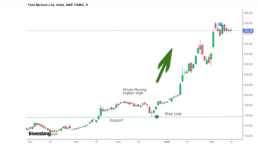
Stock Market Trends: Identifying Opportunities for Profit
[ad_1]
Stock Market Trends: Identifying Opportunities for Profit
The stock market is a dynamic and ever-changing environment that offers numerous opportunities for investors to profit. However, navigating the market can be challenging, as trends and patterns constantly shift. In this article, we will explore the concept of stock market trends and how investors can identify opportunities for profit.
Understanding Stock Market Trends
Stock market trends refer to the general direction in which stock prices are moving over a given period. These trends can be categorized as either bullish (upward), bearish (downward), or sideways (no clear direction). Identifying and understanding these trends is crucial for investors to make informed decisions and maximize their returns.
Trends can be observed across different timeframes, ranging from short-term (intraday) to long-term (months or years). Short-term trends are influenced by daily market sentiment, news, and technical indicators, while long-term trends are driven by fundamental factors such as economic growth, industry performance, and company earnings.
Identifying Trends
There are several methods and tools that investors can use to identify stock market trends. Here are some commonly employed techniques:
1. Technical Analysis: Technical analysis involves studying historical price and volume data to identify patterns and trends. Charting tools, such as moving averages, trendlines, and oscillators, can help investors spot key levels of support and resistance, as well as potential trend reversals.
2. Fundamental Analysis: Fundamental analysis focuses on evaluating a company’s financial health, industry position, and growth prospects. By analyzing factors such as earnings, revenue, debt levels, and market share, investors can assess the long-term potential of a stock and identify trends that may drive its performance.
3. Market Sentiment: Market sentiment refers to the overall attitude and perception of investors towards the market. Positive sentiment often leads to bullish trends, while negative sentiment can result in bearish trends. Monitoring indicators such as the VIX (volatility index), investor surveys, and news sentiment can provide insights into market sentiment.
4. Sector and Industry Analysis: Different sectors and industries often exhibit unique trends and performance patterns. By analyzing sector-specific factors such as government regulations, technological advancements, and consumer behavior, investors can identify trends that may impact specific industries and stocks within them.
5. Intermarket Analysis: Intermarket analysis involves studying the relationships between different asset classes, such as stocks, bonds, commodities, and currencies. By examining how these markets interact and influence each other, investors can identify trends that may impact
[ad_2]




